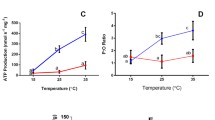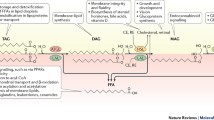Abstract
Since insect flight muscles are among the most active muscles in nature, their extremely high rates of fuel supply and oxidation pose interesting physiological problems. Long-distance flights of species like locusts and hawkmoths are fueled through fatty acid oxidation. The lipid substrate is transported as diacylglycerol in the blood, employing a unique and efficient lipoprotein shuttle system. Following diacylglycerol hydrolysis by a flight muscle lipoprotein lipase, the liberated fatty acids are ultimately oxidized in the mitochondria. Locust flight muscle cytoplasm contains an abundant fatty acid-binding protein (FABP). The flight muscle FABP ofLocusta migratoria is a 15 kDa protein with an isoelectric point of 5.8, binding fatty acids in a 1:1 molar stoichiometric ratio. Binding affinity of the FABP for longchain fatty acids (apparent dissociation constant Kd=5.21±0.16 μM) is however markedly lower than that of mammalian FABPs. The NH2-terminal amino acid sequence shares structural homologies with two insect FABPs recently purified from hawkmoth midgut, as well as with mammalian FABPs. In contrast to all other isolated FABPs, the NH2 terminus of locust flight muscle FABP appeared not to be acetylated. During development of the insect, a marked increase in fatty acid binding capacity of flight muscle homogenate was measured, along with similar increases in both fatty acid oxidation capacity and citrate synthase activity. Although considerable circumstantial evidence would support a function of locust flight muscle FABP in intracellular uptake and transport of fatty acids, the finding of another extremely well-flying migratory insect, the hawkmothAcherontia atropos, which employs the same lipoprotein shuttle system, however contains relatively very low amounts of FABP in its flight muscles, renders the proposed function of FABP in insect flight muscles questionable.
Similar content being viewed by others
References
Glatz JFC, Van der Vusse GJ, Veerkamp JH: Fatty acid-binding proteins and their physiological significance. News Physiol Sci 3: 41–43, 1988
Spener F, Börchers T, Mukherjea M: On the role of fatty acid binding proteins in fatty acid transport and metabolism. FEBS Lett 244: 1–5, 1989
Glatz JFC, Van der Vusse GJ: Cellular fatty acid-binding proteins: current concepts and future directions. Mol Cell Biochem 98: 237–251, 1990
Kaikaus RM, Bass NM, Ockner RK: Functions of fatty acid binding proteins. Experientia 46: 617–630, 1990
Veerkamp JH, Peeters RA, Maatman RGHJ: Structural and functional features of different types of cytoplasmic fatty acid-binding proteins. Biochim Biophys Acta 1081: 1–24, 1991
Beenakkers AMTh, Van der Horst DJ, Van Marrewijk WJA: Role of lipids in energy metabolism. In RGH Downer (ed.) Energy Metabolism in Insects. Plenum Publishing Corporation, New York, 1981, pp 53–100
Beenakkers AMTh, Van der Horst DJ, Van Marrewijk WJA: Insect lipids and lipoproteins, and their role in physiological processes. Prog Lipid Res 24: 19–67, 1985
Shapiro JP, Law JH, Wells MA: Lipid transport in insects. Ann Rev Entomol 33: 297–318, 1988
Van der Horst DJ: Lipid transport function of lipoproteins in flying insects. Biochim Biophys Acta 1047: 195–211, 1990
Ryan RO: Dynamics of insect lipophorin metabolism. J Lipid Res 31: 1725–1739, 1990
Haunerland NH, Chisholm JM: Fatty acid binding protein in flight muscle of the locust,Schistocerca gregaria. Biochim Biophys Acta 1047: 233–238, 1990
Van der Horst DJ, Passier PCCM, Beenakkers AMTh: Lipid transport in the blood of flying insects: fatty acid binding protein in locust flight muscles (Abstr): Abstr 31st Int Conf Biochem Lipids, Münster, 1990, p. 76
Smith AF, Tsuchida K, Hanneman E, Suzuki T, Wells MA: Isolation, characterization, and cDNA sequence of two fatty acid-binding proteins from the midgut ofManduca sexta larvae. J Biol Chem 267: 380–384, 1992
Van der Horst DJ, Baljet AMC, Beenakkers AMTh, Van Handel E: Turnover of locust haemolymph diglycerides during flight and rest. Insect Biochem 8: 369–373, 1978
Schacterle GR, Pollack RL: A simplified method for the quantitative assay of small amounts of protein in biological material. Anal Biochem 51: 654–655, 1973
Van der Horst DJ, Beenakkers AMTh, Van Doorn JM, Gerritse K, Schulz TKF: Adipokinetic hormone-induced lipid mobilization and lipophorin interconversions in fifth larval instar locusts. Insect Biochem 17: 799–808, 1987
Van der Horst DJ, Van Doorn JM, Voshol H, Kanost MR, Ziegler R, Beenakkers AMTh: Different isoforms of an apoprotein (apolipophorin III) associate with lipoproteins inLocusta migratoria. Eur J Biochem 196: 509–517, 1991
Glatz JFC, Veerkamp JH: A radiochemical procedure for the assay of fatty acid binding by proteins. Anal Biochem 132: 89–93, 1983
Vork MM, Glatz JFC, Surtel DAM, Van der Vusse GJ: Assay of the binding of fatty acids by proteins: evaluation of the Lipidex 1000 procedure. Mol Cell Biochem 98: 111–117, 1990
Glatz JFC, Veerkamp JH: Postnatal development of palmitate oxidation and mitochondrial enzyme activities in rat cardiac and skeletal muscle. Biochim Biophys Acta 711: 327–335, 1982
Shepherd D, Garland PB: Citrate synthase from rat liver. Meth Enzymol 13: 11–16, 1969
Surholt B, Schulz TKF, Goldberg J, Van der Horst DJ, Beenakkers AMTh: Lipophorin conversions during flight of the death's-head hawkmothAcherontia atropos. Insect Biochem 18: 117–126, 1988
Peeters RA, In't Groen MAPM, Veerkamp JH: The fatty acid-binding protein from human skeletal muscle. Arch Biochem Biophys 274: 556–563, 1989
Bernier I, Jollès P: A survey on cytosolic non-enzymic proteins involved in the metabolism of lipophilic compounds: from organic anion binders to new protein families. Biochimie 69: 1127–1152, 1987
Beenakkers AMTh, Van den Broek AThM, De Ronde ThJA: Development of catabolic pathways in insect flight muscles. A comparative study. J Insect Physiol 21: 849–859, 1975
Surholt B, Goldberg J, Schulz TKF, Beenakkers AMTh, Van der Horst DJ: Lipoproteins act as a reusable shuttle for lipid transport in the flying death's-head hawkmoth,Acherontia atropos. Biochim Biophys Acta 1086: 15–21, 1991
Author information
Authors and Affiliations
Rights and permissions
About this article
Cite this article
van der Horst, D.J., van Doorn, J.M., Passier, P.C.C.M. et al. Role of fatty acid-binding protein in lipid metabolism of insect flight muscle. Mol Cell Biochem 123, 145–152 (1993). https://doi.org/10.1007/BF01076486
Issue Date:
DOI: https://doi.org/10.1007/BF01076486




